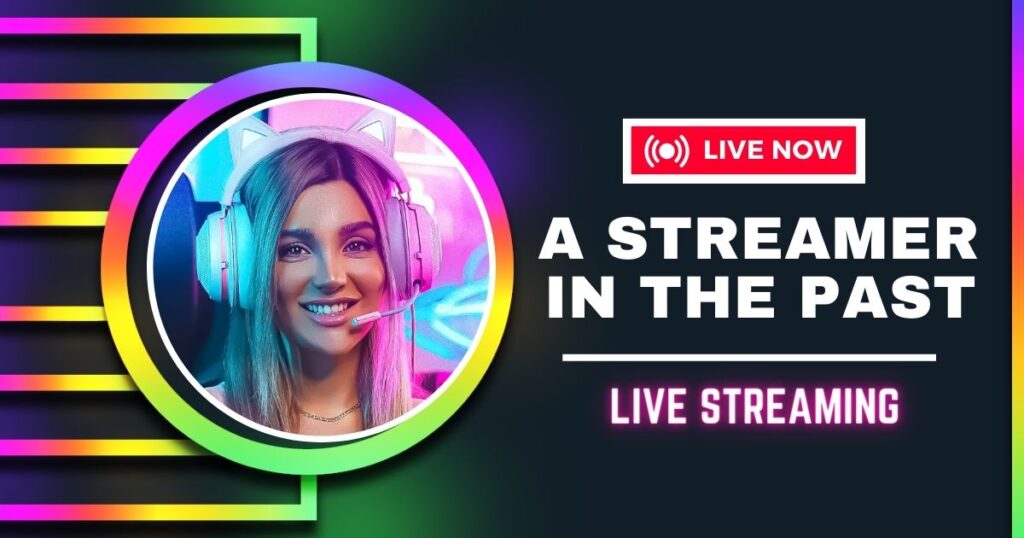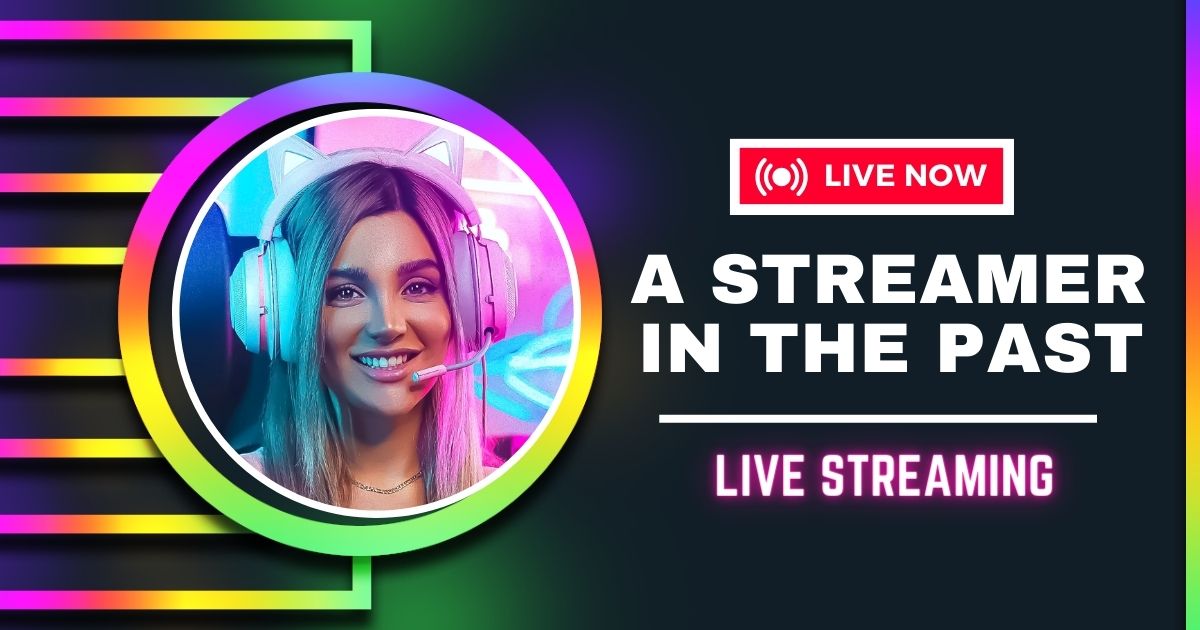A Streamer in the Past: Reflecting on the Early Days of Streaming

Streaming has become a major part of modern entertainment, with platforms like Twitch, YouTube, and Facebook Gaming leading the charge. But have you ever wondered how it all started? Let’s take a trip down memory lane to explore the journey of a streamer in the past, reflecting on the early days of streaming and how it has evolved over the years.
What Were the Early Days of Streaming Like?
The Birth of Streaming
Back in the early 2000s, streaming wasn’t the polished and professional experience it is today. Instead, it was a raw and experimental medium, pioneered by tech enthusiasts and gamers who saw the potential to share their experiences in real-time. Platforms like Justin.tv, which launched in 2007, were among the first to offer live streaming to a broad audience.
Technical Challenges
In those days, streamers faced numerous technical hurdles. Internet speeds were slower, and the software for streaming was rudimentary. Most streamers had to cobble together their setups using webcams and basic capture cards. It wasn’t uncommon for streams to be plagued by lag, buffering, and crashes.
Building Communities

Despite the technical challenges, the early streaming community was incredibly tight-knit. Streamers often interacted directly with their viewers, building strong, loyal communities. This direct engagement was one of the key factors that set streaming apart from traditional media.
| Year | Key Developments in Streaming |
|---|---|
| Early 2000s | Live streaming begins to emerge |
| 2007 | Justin.tv launches |
| 2011 | Twitch.tv is launched as a spin-off of Justin.tv |
| 2014 | Amazon acquires Twitch |
| 2015 | YouTube launches YouTube Gaming |
How Did Streamers Monetize Their Content?
Early Monetization Methods
In the beginning, monetization options were limited. Many streamers relied on donations from their viewers to support their channels. Platforms like PayPal were commonly used for this purpose. Some streamers also ran advertisements or partnered with small brands for sponsorships.
The Rise of Subscriptions and Bits
As platforms evolved, so did monetization methods. Twitch introduced its subscription model in 2011, allowing viewers to support their favorite streamers on a recurring basis. This was a game-changer, providing streamers with a more stable and predictable income. Later, features like Twitch Bits (virtual currency used for cheering) further expanded monetization opportunities.
Sponsorships and Brand Deals
With the growth of the streaming industry, brands began to take notice. Streamers started securing lucrative sponsorships and brand deals, promoting products to their audiences. This marked a significant shift, as streaming became a viable full-time career for many.
| Monetization Method | Description |
|---|---|
| Donations | Direct contributions from viewers |
| Advertisements | Revenue from ads displayed during streams |
| Subscriptions | Monthly payments from viewers for exclusive content |
| Bits/Cheers | Virtual currency used to support streamers |
| Sponsorships | Partnerships with brands to promote products |
What Content Did Early Streamers Focus On?
Gaming Dominance
In the early days, gaming was the primary content focus for streamers. Games like “World of Warcraft,” “StarCraft,” and “League of Legends” dominated the streaming landscape. Streamers shared their gameplay, offered tips and tricks, and engaged in live commentary, creating a new form of entertainment that quickly gained popularity.
Variety Streams
While gaming was at the forefront, some early streamers experimented with different types of content. Variety streams, which included anything from cooking shows to music performances, began to emerge. This laid the groundwork for the diverse range of content we see today on streaming platforms.
IRL (In Real Life) Streaming
Justin Kan, the co-founder of Justin.tv, famously livestreamed his daily life, essentially creating the IRL streaming genre. This raw, unfiltered look into someone’s life captivated audiences and demonstrated the potential for streaming beyond gaming.
Community Engagement
Early streamers placed a strong emphasis on community engagement. They interacted with viewers in real-time, responding to comments and building a sense of community. This interactivity was a unique feature of streaming, distinguishing it from pre-recorded video content.
How Has Streaming Technology Evolved?
Improved Internet Speeds
One of the most significant advancements has been the improvement in internet speeds. Faster internet connections have allowed for higher quality streams with less buffering and lag. This has made streaming more accessible and enjoyable for both streamers and viewers.
Advanced Streaming Software
Early streamers had to rely on basic and often unreliable software. Today, sophisticated streaming software like OBS (Open Broadcaster Software), Streamlabs, and XSplit provide streamers with a wide range of tools and features, from overlays and alerts to integrated chat and donation systems.
High-Quality Equipment
The evolution of streaming equipment has also been dramatic. Modern streamers have access to high-definition cameras, professional microphones, and powerful computers that can handle the demands of streaming. This has significantly improved the production quality of streams.
| Aspect | Early Days | Modern Day |
|---|---|---|
| Internet Speed | Slow, frequent buffering | High-speed, smooth streaming |
| Streaming Software | Basic, limited features | Advanced, feature-rich |
| Equipment | Webcams, basic capture cards | HD cameras, professional microphones |
| Viewer Interaction | Simple chat | Integrated chat, alerts, and more |
What Impact Did Early Streamers Have on Today’s Streaming Culture?
Pioneering New Formats
Early streamers laid the groundwork for many of the formats and genres we see today. They pioneered let’s plays, live commentary, and IRL streaming, setting the stage for the diverse content available now. Their creativity and willingness to experiment shaped the streaming culture.
Building Strong Communities
The strong emphasis on community building in the early days continues to influence streaming culture today. Streamers and viewers alike value the sense of belonging and interactivity that streaming provides. This community-centric approach remains the cornerstone of successful streaming.
Influencing Platform Development
The feedback and needs of early streamers played a crucial role in the development of streaming platforms. Features like subscriptions, bits, and advanced moderation tools were introduced in response to streamer demands. Platforms continue to evolve based on streamer and viewer feedback.
Shaping Viewer Expectations
Early streamers set the standard for what viewers expect from streams. Authenticity, interactivity, and high-quality content became the norm, driving the expectations of today’s viewers. This has pushed modern streamers to continually innovate and improve their content.
What Challenges Did Early Streamers Face?
Technical Limitations
Early streamers had to navigate numerous technical challenges. Limited internet speeds, unreliable software, and low-quality equipment made streaming a daunting task. Many streamers spent hours troubleshooting and optimizing their setups.
Monetization Struggles
Monetizing content was a significant challenge. Without the robust monetization options available today, early streamers often relied on viewer donations and small ad revenues. This made it difficult to sustain streaming as a full-time career.
Building an Audience
In the early days, streaming platforms were not as crowded, but this also meant there were fewer viewers. Building an audience required significant effort and perseverance. Streamers had to be consistent and engaging to attract and retain viewers.
Platform Stability
streaming platforms themselves were often unstable. Justin.tv, for instance, experienced frequent downtime and technical issues. This unreliability made it challenging for streamers to maintain a consistent presence.
| Challenge | Early Days | Modern Day |
|---|---|---|
| Technical Limitations | Slow internet, basic software, low-quality equipment | Fast internet, advanced software, high-quality equipment |
| Monetization Struggles | Limited options, reliance on donations | Diverse options, stable income |
| Audience Building | Few viewers, high effort required | Larger audience, more competition |
| Platform Stability | Frequent downtime, technical issues | Reliable, feature-rich platforms |
How Did Early Streamers Influence Modern Content Creation?
Setting Content Trends
Early streamers were trendsetters. Their innovative content, whether it was a unique gameplay style or a creative IRL stream, set trends that others followed. Today’s content creators continue to draw inspiration from these early pioneers.
Emphasizing Authenticity
One of the hallmarks of early streaming was authenticity. Streamers were genuine and relatable, often sharing personal stories and interacting closely with their audiences. This emphasis on authenticity remains a key element of successful content creation.
Driving Platform Features
The needs and feedback of early streamers drove the development of platform features that are now standard. From chat moderation tools to advanced analytics, many of the features streamers rely on today were shaped by the experiences of those early adopters.
Encouraging Diverse Content
The experimentation and diversity of content in the early days encouraged a culture of creativity. Streamers felt free to try new things, leading to a wide variety of content genres. This culture of creativity continues to thrive, with new and unique content constantly emerging.
What Lessons Can Modern Streamers Learn from the Past?
Adaptability is Key
Early streamers had to be highly adaptable, often working with limited resources and overcoming technical challenges. Modern streamers can learn from this adaptability, being open to new technologies and changes in the streaming landscape.
Community is Everything
Building a strong, loyal community was crucial for early streamers, and it remains essential today. Engaging with viewers, fostering a sense of belonging, and creating a positive environment can make a significant difference in a streamer’s success.
Consistency Pays Off
Consistency was vital for early streamers to build and maintain their audiences. Regular streaming schedules, consistent content quality
, and reliable engagement helped them grow. Modern streamers can benefit from maintaining consistency in their streaming practices.
Embrace Innovation
Early streamers were innovators, constantly experimenting with new content formats and technologies. Modern streamers should embrace this spirit of innovation, continually seeking to improve and differentiate their content.
How Has the Audience Experience Evolved?
Increased Interaction
In the early days, interaction between streamers and viewers was limited to simple chat messages. Today, streamers have a myriad of tools at their disposal to engage with their audience, from integrated chat functions to interactive polls and games. This increased interaction has made streams more engaging and immersive.
Personalized Viewing Experience
Modern streaming platforms offer personalized viewing experiences, with recommendations based on viewer preferences and watch history. This helps viewers discover new content and streamers that align with their interests, enhancing their overall, higher-quality experience.
Higher Quality Streams
Advancements in technology have significantly improved the quality of streams. High-definition video, better audio, and smoother streaming have all contributed to a more enjoyable viewing experience. Viewers now expect high production values and professional-quality streams.
Community Building
The sense of community has only grown stronger. Viewers often form sub-communities within a streamer’s audience, connecting with others who share similar interests. This sense of belonging and connection keeps viewers coming back and fosters loyalty to the streamer.
| Viewer Experience Aspect | Early Days | Modern Day |
|---|---|---|
| Interaction | Simple chat | Integrated chat, interactive tools |
| Personalization | Limited | Advanced recommendations |
| Stream Quality | Low-resolution, frequent buffering | High-definition, smooth streaming |
| Community Building | Small, tight-knit communities | Larger, diverse sub-communities |
What Are the Major Milestones in Streaming History?
Launch of Twitch
One of the most significant milestones in streaming history was the launch of Twitch.tv in 2011. As a spin-off of Justin.tv focused on gaming, Twitch quickly became the go-to platform for live streaming video games. Its success highlighted the potential of streaming as a mainstream entertainment medium.
Amazon Acquires Twitch
In 2014, Amazon acquired Twitch for nearly $1 billion. This acquisition underscored the growing importance of streaming in the digital landscape and provided Twitch with the resources to expand and innovate further.
Introduction of Subscriptions and Bits
Twitch’s introduction of subscriptions in 2011 and bits in 2016 revolutionized monetization for streamers. These features provided more stable and predictable income sources, enabling many streamers to pursue streaming as a full-time career.
Rise of YouTube Gaming
In 2015, YouTube launched YouTube Gaming to compete with Twitch. This move by one of the largest video platforms in the world validated the importance of live streaming and brought more attention to the industry.
Emergence of Mixer
Mixer, originally known as Beam, was launched in 2016 and acquired by Microsoft shortly thereafter. Although it ultimately shut down in 2020, Mixer’s innovative features, such as low-latency streaming and interactive capabilities, influenced other platforms.
COVID-19 Pandemic Impact
The COVID-19 pandemic in 2020 led to a surge in streaming activity as people sought entertainment and connection while staying at home. This period saw record growth for platforms like Twitch, YouTube Gaming, and Facebook Gaming.
| Year | Major Milestones |
|---|---|
| 2011 | Launch of Twitch |
| 2014 | Amazon acquires Twitch |
| 2011, 2016 | Introduction of subscriptions and bits on Twitch |
| 2015 | Launch of YouTube Gaming |
| 2016 | Launch and acquisition of Mixer by Microsoft |
| 2020 | COVID-19 pandemic leads to streaming boom |
What Future Trends Can We Expect in Streaming?
Increased Interactivity
Future streaming trends point towards even greater interactivity. Features like real-time viewer participation, interactive overlays, and augmented reality elements will make streams more engaging and immersive.
Expanded Content Diversity
As the streaming landscape continues to grow, we can expect to see an even wider variety of content. From educational streams to virtual events and beyond, the possibilities are endless. This diversity will attract new audiences and provide more opportunities for streamers.
Integration with Other Technologies
Streaming will increasingly integrate with other technologies, such as virtual reality (VR) and artificial intelligence (AI). VR can provide immersive experiences, while AI can enhance personalization and moderation, improving both streamer and viewer experiences.
Enhanced Monetization Options
Monetization will continue to evolve, offering streamers more ways to earn income. This could include new forms of virtual goods, enhanced ad formats, and innovative sponsorship opportunities. The goal will be to provide sustainable income streams for more creators.
Focus on Community Building
The emphasis on community will remain strong. Platforms will develop new tools to help streamers build and maintain their communities, fostering deeper connections and enhancing viewer loyalty.
Global Expansion
Streaming is set to expand further globally. As internet infrastructure improves worldwide, more people will gain access to high-quality streams. This will open up new markets and audiences, driving further growth in the industry.
| Future Trend | Description |
|---|---|
| Increased Interactivity | Real-time participation, interactive overlays |
| Expanded Content Diversity | Wider variety of content, attracting new audiences |
| Integration with Technologies | VR and AI integration for immersive experiences |
| Enhanced Monetization | New income streams, sustainable monetization |
| Focus on Community | New tools for community building and engagement |
| Global Expansion | Improved access and new markets |
Conclusion
Reflecting on the early days of streaming reveals a journey marked by innovation, community building, and overcoming challenges. Early streamers paved the way for the vibrant and diverse streaming culture we enjoy today. By understanding their experiences and learning from their successes and struggles, modern streamers can continue to push the boundaries of what is possible in the world of live streaming. Whether you’re a streamer or a viewer, the legacy of those early pioneers is a testament to the power of creativity and connection in the digital age.
In today’s fast-paced streaming environment, remembering the roots and evolution of streaming can provide valuable insights. The adaptability, community focus, and innovative spirit of early-streamers are lessons that continue to resonate. As technology advances and the streaming landscape evolves, these principles will guide the next generation of streamers towards even greater heights.
FAQs
What Was the First Major Streaming Platform?
Justin.tv, launched in 2007, was one of the first major streaming platforms. It later evolved into Twitch.tv, which became the leading platform for live streaming.
How Did Early Streamers Monetize Their Content?
Early streamers primarily relied on viewer donations, advertisements, and small sponsorships. The introduction of subscriptions and bits on platforms like Twitch provided more stable monetization options.
What Challenges Did Early Streamers Face?
Early streamers dealt with slow internet speeds, basic streaming software, low-quality equipment, and platform instability. Monetization and audience building were also significant challenges.
How Has Streaming Technology Evolved?
Streaming technology has advanced significantly with faster internet speeds, sophisticated streaming software, high-quality equipment, and stable, feature-rich platforms.
What Lessons Can Modern Streamers Learn from Early Streamers?
Modern streamers can learn the importance of adaptability, community engagement, consistency, and innovation from early streamers. These principles remain essential for success in today’s streaming landscape.



